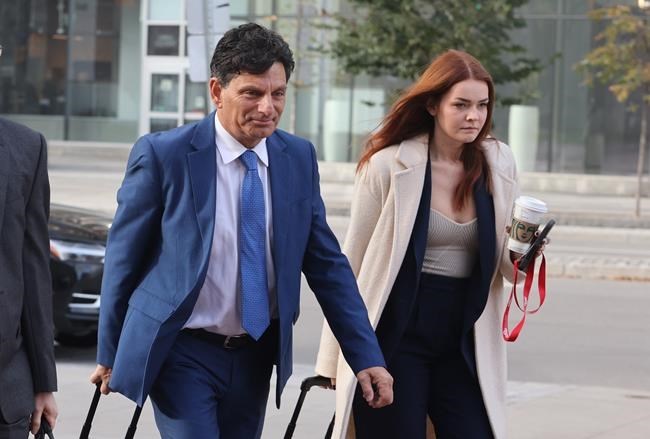OTTAWA — An officer who served as a liaison between the "Freedom Convoy" and police told an Ottawa courtroom Wednesday that there were several convoys headed to the capital to protest last year.
Const. Isabelle Cyr first took the stand on the second day of the criminal trial of Tamara Lich and Chris Barber in September. The cross-examination was halted after the defence requested a copy of police chat messages and emails.
She returned to court Wednesday to answer questions about her role as point person for some of the organizers associated with Lich and Barber's group.
Cyr first reached out to Chris Barber before the convoy arrived in Ottawa to try to get "concrete information" about how the protest would unfold, she said, and was passed on to another organizer, Chris Garrah. She had nearly daily contact with Garrah thereafter.
Under cross-examination, she said Garrah told her that protesters associated with the official "Freedom Convoy" group were expected to register in order to receive funds for food and fuel. They also had to sign a code of conduct, though she never saw a copy of it.
Barber and Lich face several charges, including mischief and counselling others to commit mischief. The Crown hopes to prove that the two exerted influence over the massive crowd of protesters that gridlocked Ottawa for more than three weeks in protest against public-health restrictions.
The defence, meanwhile, has highlighted that the protest included several groups with various aims and ideological positions. That point was made at a meeting Cyr attended about a week before the convoy arrived in Ottawa, she said in her testimony.
There was some concern voiced at a police intelligence meeting on Jan. 25 that various additional groups had joined the cause, and that there would be "difficulty controlling everyone," Lich's lawyer Lawrence Greenspon said. Cyr agreed with his statement.
On Jan. 27, only a few days before the protesters arrived, Cyr asked her fellow police liaison officers in a group chat whether they knew how many different convoys would be arriving in Ottawa, aside from "Bauder's crew."
James Bauder, the co-founder of a group called Canada Unity, collaborated with Barber, Lich and others to organize the initial convoy.
"You didn’t know how many convoys would be arriving at that time?" Greenspon asked Cyr.
"No, I didn't," she replied.
In the group chat, Cyr noted that several of the trucks that arrived on Jan. 30 from Quebec belonged to a group called "Les Farfadets."
Her message may be a reference to the group "Les Farfadaas," which had a large presence during the convoy protest and was a vocal opponent of COVID-19 public-health measures in Quebec.
Greenspon also revisited evidence from past testimony in the trial about how long police expected to the protest to last and where they directed big-rig trucks and other convoy vehicles to park.
He asked about earlier testimony from Insp. Russell Lucas, who told the court that officers' efforts to shrink the footprint of the protest were thwarted by directions from senior command after the first weekend "not to give the protesters an inch."
Cyr said there were times she asked for permission to move trucks, but Lucas denied those requests.
One of those cases involved protesters associated with Les Farfadaas. Their trucks were located a short distance away from the epicentre of the protest, but they requested to move them closer to where other demonstrators had parked.
On Feb. 11, another liaison officer, Sgt. Fong Le, told the group chat that officers' lack of authority led to a "catastrophic failure," which only empowered the Farfadaas protesters and let them know just how valuable their position was.
The Crown is expected to call more police officers who worked in a liaison role during the convoy later this week.
This report by The Canadian Press was first published Oct. 18, 2023.
Laura Osman, The Canadian Press



